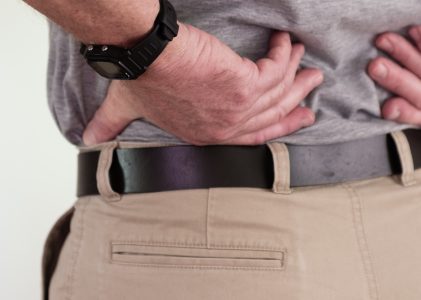The jarring effect of accidents and falls may cause muscles to tighten in protective spasm and body stress to present into the lower back. Additionally, poor posture, heavy or incorrect lifting, bending forward and repetitive jarring exercises may strain ligaments and muscles and result in pain or discomfort in the lower back, hip and pelvic areas.
Irritation to the spinal nerves of the lower back may result in nagging back pain and this may refer along the nerve pathways into the abdomen, groin, hips, legs or feet. Often pain is felt along the large sciatic nerve which passes through the buttock and down the back of the leg. There may also be sensations of numbness in any of these areas. Muscle function may be affected, resulting in stiffness or weakness, difficulty standing for long periods of time or difficulty rising from a seated position.
The compressive effect of tightened muscles in the lower back area may be severe and result in the spine pulling sideways or forwards. While body stress remains stored in the lower back, the irritation to the nerves may undermine or disturb the normal functioning of the areas and organs they supply – often leading to digestive problems, such as constipation, diarrhea or IBS, bladder complaints, fertility issues etc.
Sometimes a person may not be aware of the body stress in the lower back other than feeling lower back or hip stiffness on arising in the morning.
If the body stress has been present in the lower back for a long time (the cause may have originated in childhood), it may be necessary for the stored tension to be released in “layers” over a period of time. Some clients may respond relatively quickly as the tensions start to release (particularly if the spasm is recent and not a long standing issue) while other’s may find they go through quite a process as the deeper layers of tension start to release over time. As the deep layers of protective action and tension release muscle tone starts to change and clients may experience better mobility and flexibility. Since the lower back, hips and pelvis area are the foundation of the spine, the lower spine affects the stability of the rest of the spine. Therefore, if body stress is stored in the lumbar area, muscular tension will be referred to the upper back and neck.
Severe Calf Pain:
A 48 year old man was experiencing such intense calf pain that he was unable to walk. He was not aware of any pain in his lower back. A week of traction in hospital had not eased the problem. After the first BSR session the lower back become very painful as feeling was restored to numbed nerves.
The calf pain was unchanged. After the second session three days later the pain withdrew from the calves and was felt in the hips and lower back. After further releases 5 days later, the pain in the lower back began to lessen.
The final session was 3 days after that. Within two weeks the client was pain-free and was able to return to work.
Leg pains and heart burn:
An Electrical Engineer, aged 39 described the pain in his legs as excruciating – he couldn’t sleep without taking pain medication. He was examined by neurologists who concluded that his Sciatic nerves were inflamed but they could find no apparent cause. His only other complaint was heart burn. The BSR stress tests revealed tension locked into the lower back, which was exerting a pull on the diaphragm muscle, and pressure over the coccyx.
Immediately after the releases the leg pain lessened and his lower back started aching (showing that compression was being lifted from the source of the area, increasing feeling along the decompressed nerve pathways). After the second session he had no pain at all in the legs and the lower back improved. He was now able to sleep through the night and no longer needed pain killers. As a bonus, with the diaphragm free of tension the man no longer experienced heartburn!
Bed Wetting:
For a number of years a 15 year old boy had experienced the embarrassment of frequent bed-wetting, as well as intermittent lower back pain. After three sessions, in which pressure was released in the lumbar spine, he had no further bladder problems. The bed-wetting recurred a year later after a heavy fall at rugby, but cleared up once more after two sessions of BSR.
Foot Rotation:
A 31 year old woman had walked with one foot rotated outwards, ever since a motor accident in her teens. She frequently woke with her lower back in a painful spasm. She underwent regular BSR over a period of 3 months. Her foot was restored to its normal position and her buttock muscles, which had been wasted, had rebuilt.
Infertility:
A woman in her mid-twenties was longing for a baby but her gynecologist found that she was not ovulating. Also her knee and foot reflexes were absent, which implied some spinal nerve compression. She came to BSR because of long term lower back pain. After several months of regular releases her back had improved and she fell pregnant! She received another bonus as it turned out that she was having twins!
Bladder infections:
A young woman suffered from recurrent bouts of a bladder infection. The problem would clear up with antibiotics but would soon re-appear again along with lower back stiffness. After three sessions of BSR the cystitis ceased. It would seem that with nerve communication being restored to the bladder the immune system was able to function efficiently to deal with the infection.



